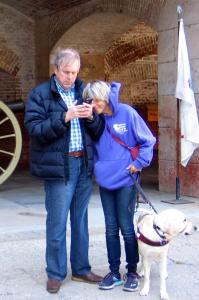UH Mānoa researchers receive $100,000 to expand media-accessibility at national parks
University of Hawaiʻi at MānoaResearchers at the University of Hawaiʻi at Mānoa received a $100,000 grant from Google to continue efforts to audio-describe the world for blind and visually impaired visitors to National Park Service sites. The award will expand the scope of the UniDescription (UniD) project to 30 national parks, predominantly in the northeast portion of the United States.
“The UniDescription project began in the fall of 2014 as a way to improve and encourage better audio description of visual media, such as photos or park brochures, and allow the ear to hear what the eye might not see,” said Brett Oppegaard, principal investigator and associate professor at the School of Communications in the College of Social Sciences. “At the end of this phase of the project, UniD audio description will be available for public use through mobile apps and websites at 85 National Park Service sites across the country, including some of the most treasured places in the nation, such as Yellowstone National Park, the Statue of Liberty National Monument, Yosemite National Park, the Washington Monument and Hawai‘i Volcanoes National Park.”
The UH team is led by Oppegaard, UH Center on Disability Studies (CDS) Director Patricia Morrissey, CDS Assistant Professor Megan Conway and CDS Media Coordinator Thomas Conway. They plan to utilize a portion of the grant and combine it with a similar-oriented grant of $50,000 provided by Google in May to offer a hackathon-like Descriptathon in January with an expanded number of park staff from around the region. Field tests with members of the American Council of the Blind at those sites and other forms of stakeholder feedback and evaluation will follow.
This is the third grant awarded to the project by Google. Together the grants total $225,000. The project has also received two National Park Service grants totalling $344,800. Partners on the UniDescription project include CDS, American Council of the Blind and Harpers Ferry Center, which is the design hub of the National Park Service.
The UniDescription app is available for free in both the Android and Apple markets. For more information about this project, visit www.unidescription.org.
Photo caption:
Representatives of the American Council of the Blind, including Silicon Valley chapter members John and Susan Glass, shown here, recently tested Fort Point National Historic Site's new audio-described brochure. Photo courtesy of Jim Taylor.
More about the School of Communications
The School of Communications in the College of Social Sciences at the University of Hawai‘i at Mānoa offers academic programs in Communication and Journalism. Communication focuses on communication in intercultural and professional communities, information and communication technologies (ICTs) and policy, and the media arts. Journalism is professionally oriented and develops critical thinking skills and ability to gather, analyze, and organize information, and to communicate it clearly and responsibly through print, broadcast, and online media.
More about the College of Social Sciences
The College of Social Sciences (CSS) at the University of Hawai‘i at Mānoa is engaged in a broad range of research endeavors that address fundamental questions about human behavior and the workings of local, national and international political, social, economic and cultural institutions. Its vibrant student-centered academic climate supports outstanding scholarship through internships, and active and service learning approaches to teaching that prepare students for the life-long pursuit of knowledge.

